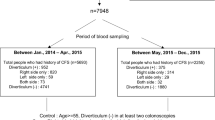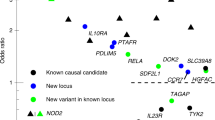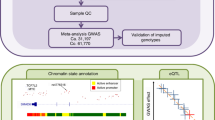Abstract
We have mapped a locus on chromosome 7p22.3-7p15.3 spanning a 22.4 Mb region for ulcerative colitis (UC) by whole genome linkage analyses of a large Danish family. The family represent three generations with UC segregating as an autosomal dominant trait with variable expressivity. The whole-genome scan resulted in a logarithm of odds score (LOD score) of Z = 3.31, and a whole genome sequencing (WGS) of two affected excluded disease-causing mutations in the protein coding genes. Two rare heterozygote variants, rs182281985:G>A and rs541426369:G>A, both with low allele frequencies (MAF A:0.0001, gnomAD ver3.1.2), were found in clusters of ChiP-seq transcription factors binding sites close to the AHR (aryl hydrocarbon receptor) gene and the UC associated SNP rs1077773:G>A. Testing the two SNPs in a promoter reporter assay for regulatory activity revealed that rs182281985:G>A influenced the AHR promoter. These results suggest a regulatory region that include rs182281985:G>A close to the UC GWAS SNP rs1077773:G>A and further demonstrate evidence that the AHR gene on the 7p-tel region is a candidate susceptible gene for UC.
This is a preview of subscription content, access via your institution
Access options
Subscribe to this journal
Receive 12 print issues and online access
$259.00 per year
only $21.58 per issue
Buy this article
- Purchase on Springer Link
- Instant access to full article PDF
Prices may be subject to local taxes which are calculated during checkout


Similar content being viewed by others
Data availability
The datasets generated and/or analyzed during the current study are available from the corresponding author on reasonable request.
References
Sairenji T, Collins KL, Evans DV. An update on inflammatory bowel disease. Prim Care. 2017;44:673–92. https://doi.org/10.1016/j.pop.2017.07.010.
Torres J, Mehandru S, Colombel JF, Peyrin-Biroulet L. Crohn’s disease. Lancet. 2017;389:1741–55. https://doi.org/10.1016/S0140-6736(16)31711-1.
Ungaro R, Mehandru S, Allen PB, Peyrin L, Colombel J-F. Ulcerative colitis. Lancet. 2017;389:1756–70. https://doi.org/10.1016/S0140-6736(16)32126-2.
Ng SC, Shi HY, Hamidi N, Underwood FE, Tang W, Benchimol EI, et al. Worldwide incidence and prevalence of inflammatory bowel disease in the 21st century: a systematic review of population-based studies. Lancet. 2017;390:2769–78. https://doi.org/10.1016/S0140-6736(17)32448-0.
Ellinghaus D, Bethune J, Petersen BS, Franke A. The genetics of Crohn’s disease and ulcerative colitis-status quo and beyond. Scand J Gastroenterol. 2014;50:13–23. https://doi.org/10.3109/00365521.2014.990507.
Bager P, Gørtz S, Feenstra B, Andersen NN, Jess T, Frisch M, et al. Increased risk of inflammatory bowel disease in families with tonsillectomy: a Danish national cohort study. Epidemiology. 2019;30:256–62. https://doi.org/10.1097/EDE.0000000000000946.
Santos MPC, Gomes C, Torres J. Familial and ethnic risk in inflammatory bowel disease. Ann Gastroenterol. 2018;31:14–23. https://doi.org/10.20524/aog.2017.0208.
Younis N, Zarif R, Mahfouz R. Inflammatory bowel disease: between genetics and microbiota. Mol Biol Rep. 2020;47:3053–63. https://doi.org/10.1007/s11033-020-05318-5.
Orholm M, Munkholm P, Langholz E, Nielsen OH, Sørensen TIA, Binder V. Familial occurrence of inflammatory bowel disease. N. Engl J Med. 1991;324:84–88. https://doi.org/10.1056/NEJM199101103240203.
Brant SR. Update on the heritability of inflammatory bowel disease: the importance of twin studies. Inflamm Bowel Dis. 2011;17:1–5. https://doi.org/10.1002/ibd.21385.
Liu JZ, van Sommeren S, Huang H, Ng SC, Alberts R, Takahashi A, et al. Association analyses identify 38 susceptibility loci for inflammatory bowel disease and highlight shared genetic risk across populations. Nat Genet. 2015;47:979–86. https://doi.org/10.1038/ng.3359.
Ellinghaus D, Jostins L, Spain SL, Cortes A, Bethune J, Han H, et al. Analysis of five chronic inflammatory diseases identifies 27 new associations and highlights disease-specific patterns at shared loci. Nat Genet. 2016;48:510–8. https://doi.org/10.1038/ng.3528.
de Lange KM, Moutsianas L, Lee JC, Lamb CA, Luo Y, Kennedy NA, et al. Genome-wide association study implicates immune activation of multiple integrin genes in inflammatory bowel disease. Nat Genet. 2017;49:256–61. https://doi.org/10.1038/ng.3760.
Huang H, Fang M, Jostins L, Mirkov MU, Boucher G, Anderson CA, et al. Fine-mapping inflammatory bowel disease loci to single-variant resolution. Nature. 2017;547:173–8. https://doi.org/10.1038/nature22969.
Mirkov MU, Verstockt B, Cleynen I. Genetics of inflammatory bowel disease: beyond NOD2. Lancet Gastroenterol Hepatol. 2017;2:224–34. https://doi.org/10.1016/S2468-1253(16)30111-X.
Corbaz A, ten Hove T, Herren S, Graber P, Schwartsburd B, Belzer I, et al. IL-18-binding protein expression by endothelial cells and macrophages is up-regulated during active Crohn’s disease. J Immunol. 2002;168:3608–16. https://doi.org/10.4049/jimmunol.168.7.3608.
Fuss IJ, Heller F, Boirivant M, Leon F, Yoshida M, Fichtner-Feigl S, et al. Nonclassical CD1d-restricted NK T cells that produce IL-13 characterize an atypical Th2 response in ulcerative colitis. J Clin Invest. 2004;113:1490–7. https://doi.org/10.1172/JCI19836.
van Heel DA, Fisher SA, Kirby A, Daly MJ, Rioux JD, Lewis CM. Inflammatory bowel disease susceptibility loci defined by genome scan meta-analysis of 1952 affected relative pairs. Hum Mol Genet. 2004;13:763–70. https://doi.org/10.1093/hmg/ddh090.
Franke A, McGovern DPB, Barrett JC, Wang K, Radford-Smith GLAhmad T, et al. Genome-wide meta-analysis increases to 71 the number of confirmed Crohn’s disease susceptibility loci. Nat Genet. 2010;42:1118–25. https://doi.org/10.1038/ng.717.
Yoneno K, Hisamatsu T, Shimamura K, Kamada N, Ichikawa R, Kitazume MT, et al. TGR5 signalling inhibits the production of pro-inflammatory cytokines by in vitro differentiated inflammatory and intestinal macrophages in Crohn’s disease. Immunology. 2013;139:19–29. https://doi.org/10.1111/imm.12045.
de Lange KM, Barrett JC. Understanding inflammatory bowel disease via immunogenetics. J Autoimmun. 2015;64:91–100. https://doi.org/10.1016/j.jaut.2015.07.013.
Eiberg H, Nielsen LS, Klausen J, Dahlén M, Kristensen M, Bisgaard M, et al. Linkage between serum cholinesterase 2 (CHE2) and ▯‑crystalline gene cluster (CRYG): assignment to chromosome 2. Clin Genet. 1989;35:313–321. https://doi.org/10.1111/j.1399-0004.1989.tb02951.x.
Ott J. A computer program for linkage analysis of general human pedigrees. Am J Hum Genet. 1976;28:528–9.
Li H, Durbin R. Fast and accurate short read alignment with Burrows-Wheeler transform. Bioinformatics. 2009;25:1754–60. https://doi.org/10.1093/bioinformatics/btp324.
DePristo MA, Banks E, Poplin R, Garimella KV, Maguire JR, Hartl C, et al. A framework for variation discovery and genotyping using next-generation DNA sequencing data. Nat Genet. 2011;43:491–8. https://doi.org/10.1038/ng.806.
Choi Y, Chan AP. PROVEAN web server: a tool to predict the functional effect of amino acid substitutions and indels. Bioinformatics. 2015;31:2745–7. https://doi.org/10.1093/bioinformatics/btv195.
Fishilevich S, Nudel R, Rappaport N, Hadar R, Plaschkes I, Stein TI, et al. GeneHancer: genome-wide integration of enhancers and target genes in GeneCards, Database. 2017. https://doi.org/10.1093/database/bax028.
Sloan CA, Chan ET, Davidson JM, Malladi VS, Strattan JS, Hitz BC, et al. ENCODE data at the ENCODE portal. Nucleic Acids Res. 2016;44(D1):D726–32. https://doi.org/10.1093/nar/gkv1160.
Lee BT, Barber GP, Benet-Pagès A, Casper J, Clawson H, Diekhans M, et al. The UCSC Genome Browser database: 2022 update. Nucleic Acids Res. 2022;50(D1):D1115–D1122. https://doi.org/10.1093/nar/gkab959.
Raman M, Martin K. One solution for cloning and mutagenesis: In-Fusion® HD Cloning Plus. Nat Methods. 2014;11:iii–v. https://doi.org/10.1038/nmeth.f.373.
Dahlgaard K, Troelsen JT. Identification and functional analysis of gene regulatory sequences interacting with colorectal tumor suppressors. Methods Mol Biol. 2018;1765:57–77. https://doi.org/10.1007/978-1-4939-7765-9_4.
Anderson CA, Boucher G, Lees CW, Franke A, D’Amato M, Taylor KD, et al. Meta-analysis identifies 29 additional ulcerative colitis risk loci, increasing the number of confirmed associations to 47. Nat Genet. 2011;43:246–52. https://doi.org/10.1038/ng.764.
Jostins L, Ripke S, Weersma RK, Duerr RH, McGovern DP, Hui KY, et al. Host-microbe interactions have shaped the genetic architecture of inflammatory bowel disease. Nature 2012;491:119–24. https://doi.org/10.1038/nature11582.
Haritunians T, Taylor KD, Targan SR, Dubinsky M, Ippoliti A, Kwon S, et al. Genetic predictors of medically refractory ulcerative colitis. Inflamm Bowel Dis. 2010;16:1830–40. https://doi.org/10.1002/ibd.21293.
Burke KE, Khalili H, Garber JJ, Haritunians T, McGovern DPB, Xavier RJ, et al. Genetic markers predict primary nonresponse and durable response to anti-tumor necrosis factor therapy in ulcerative colitis. Inflamm Bowel Dis. 2018;24:1840–8. https://doi.org/10.1093/ibd/izy083.
Khor B, Gardet A, Xavier RJ. Genetics and pathogenesis of inflammatory bowel disease. Nature. 2011;474:307–17. https://doi.org/10.1038/nature10209.
Mathew CG, Lewis CM. Genetics of inflammatory bowel disease: progress and prospects. Hum Mol Genet. 2004;13:R161–8. https://doi.org/10.1093/hmg/ddh079.
Hugot J-P, Laurent-Puig P, Gower-Rousseau C, Olson JM, Lee JC, Beaugerie L, et al. Mapping of a susceptibility locus for Crohn’s disease on chromosome 16. Nature. 1996;379:821–3. https://doi.org/10.1038/379821a0.
Hugot JP, Chamaillard M, Zouali H, Lesage S, Cézard J-P, Belaiche J, et al. Association of NOD2 leucine-rich repeat variants with susceptibility to Crohn’s disease. Nature. 2001;411:599–603. https://doi.org/10.1038/35079107.
Ogura Y, Bonen D, Inohara N, Nicolae D. A frameshift mutation in NOD2 associated with susceptibility to Crohn’s disease. Nature 2001;411:603–6. https://doi.org/10.1038/35079114.
Hampe J, Frenzel H, Mirza MM, Croucher PJP, Cuthbert A, Mascheretti S, et al. Evidence for a NOD2-independent susceptibility locus for inflammatory bowel disease on chromosome 16p. Proc Natl Acad Sci USA. 2002;99:321–6. https://doi.org/10.1073/pnas.261567999.
Negroni A, Pierdomenico M, Cucchiara S, Stronati L. NOD2 and inflammation: current insights. J Inflamm Res. 2018;11:49–60. https://doi.org/10.2147/JIR.S137606.
Philpott DJ, Sorbara MT, Robertson SJ, Croitoru K, Girardin SE. NOD proteins: regulators of inflammation in health and disease. Nat Rev Immunol. 2014;14:9–23. https://doi.org/10.1038/nri3565.
Benson JM, Shepherd DM. Aryl hydrocarbon receptor activation by TCDD reduces inflammation associated with Crohn’s disease. Toxicol Sci. 2011;120:68–78. https://doi.org/10.1093/toxsci/kfq360.
Li Y, Innocentin S, Withers DR, Roberts NA, Gallagher AR, Grigorieva EF, et al. Exogenous stimuli maintain intraepithelial lymphocytes via aryl hydrocarbon receptor activation. Cell. 2011;147:629–40. https://doi.org/10.1016/j.cell.2011.09.025.
Lamas B, Natividad JM, Sokol H. Aryl hydrocarbon receptor and intestinal immunity. Mucosal Immunol. 2018;11:1024–38. https://doi.org/10.1038/s41385-018-0019-2.
Mizoguchi A, Yano A, Himuro H, Ezaki Y, Sadanaga T, Mizoguchi E. Clinical importance of IL-22 cascade in IBD. J Gastroenterol. 2018;53:465–74. https://doi.org/10.1007/s00535-017-1401-7.
Sugimoto S, Naganuma M, Kiyohara H, Arai M, Ono K, Mori K, et al. Clinical efficacy and safety of oral Qing-Dai in patients with ulcerative colitis: a single-center open-label prospective study. Digestion. 2016;93:193–201. https://doi.org/10.1159/000444217.
Metidji A, Omenetti S, Crotta S, Li Y, Nye E, Ross E, et al. The environmental sensor AHR protects from inflammatory damage by maintaining intestinal stem cell homeostasis and barrier integrity. Immunity. 2018;49:353–62.e5. https://doi.org/10.1016/j.immuni.2018.07.010.
Cannon AS, Nagarkatti PS, Nagarkatti M. Targeting AhR as a novel therapeutic modality against inflammatory diseases. Int J Mol Sci. 2022;23:288. https://doi.org/10.3390/ijms23010288.
Acknowledgements
We thank all family members for their participation in this study and Annemette Friis Mikkelsen and Marianne Lauridsen is thanked for excellent technical assistance and Rigshospitalets Microarray Center for the genotyping. HE was supported by the Danish Medical Research Council (22-02-0208), CBB by the Innovation Fund Denmark (0603-00320B), JTT and JBO received funding from Region Zealand and Roskilde University.
Author information
Authors and Affiliations
Contributions
All authors have contributed to and approved the final manuscript and agreed to the order in which their names are listed. Hans Eiberg: Conceptualization and design of the study, linkage analysis, WGS data analysis and revising the manuscript. Josephine B Olsson: Construction of expression plasmids, cell transfection, promoter analysis and revising the manuscript. Mads Bak: WGS, alignment, and analyses of data. Claus H Bang-Berthelsen: data analysis and associations data. Jesper T Troelsen: Design of promoter analysis, interpretation of data and revising the manuscript. Lars Hansen: Design of the study, data analysis, drafting and writing the manuscript.
Corresponding author
Ethics declarations
Competing interests
The authors declare no competing interests.
Ethics approval
The study protocols adhered to the tenets of the Declaration of Helsinki and the ARVO statement on human subjects and approved by the Danish National Committee on Health Research Ethics in 2019 (H-19019167).
Additional information
Publisher’s note Springer Nature remains neutral with regard to jurisdictional claims in published maps and institutional affiliations.
Supplementary information
Rights and permissions
Springer Nature or its licensor (e.g. a society or other partner) holds exclusive rights to this article under a publishing agreement with the author(s) or other rightsholder(s); author self-archiving of the accepted manuscript version of this article is solely governed by the terms of such publishing agreement and applicable law.
About this article
Cite this article
Eiberg, H., Olsson, J.B., Bak, M. et al. A family with ulcerative colitis maps to 7p21.1 and comprises a region with regulatory activity for the aryl hydrocarbon receptor gene. Eur J Hum Genet 31, 1440–1446 (2023). https://doi.org/10.1038/s41431-023-01298-9
Received:
Revised:
Accepted:
Published:
Issue Date:
DOI: https://doi.org/10.1038/s41431-023-01298-9
This article is cited by
-
Ambivalence and regret in genome sequencing
European Journal of Human Genetics (2023)



